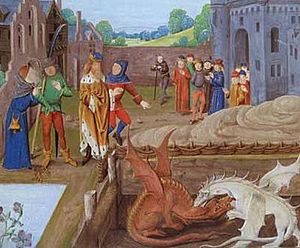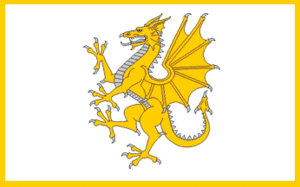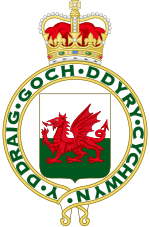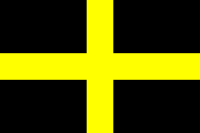Flag of Wales facts for kids
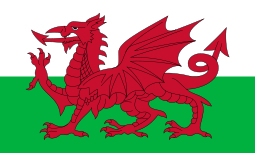 |
|
| Use | National flag |
|---|---|
| Proportion | 3:5 |
| Adopted | 1959 (current version) |
| Design | Per fess Argent and Vert, a dragon passant Gules |
The flag of Wales is called Y Ddraig Goch in Welsh, which means 'the red dragon'. It shows a red dragon walking on a green and white background. The exact way the dragon looks can change, as there are many different drawings of it. This flag is not part of the Union Flag.
The flag uses the dragon of King Cadwaladr of Gwynedd. It also includes the green and white colours of the Tudor dynasty. Henry VII used this flag in 1485 at the Battle of Bosworth. After his victory, the flag was carried to St Paul's Cathedral. The red dragon then became a symbol on the Tudor royal arms. This showed their Welsh family background. The flag was officially made the national flag of Wales in 1959. Some cities, like Cardiff, the capital of Wales, also have a dragon in their flag design.
Contents
The Red Dragon of Wales
A Look Back in Time
The Welsh flag became official in 1959. But the red dragon has been a symbol of Wales for many centuries. No one knows exactly how the dragon became a Welsh symbol. It's a mix of history and myth. One idea is that the Romans brought the dragon symbol to Wales. They used dragon standards, called Draco standards, for their cavalry. These were inspired by symbols from other ancient peoples.
The green and white stripes on the flag were added by the House of Tudor. This Welsh family ruled the English throne from 1485 to 1603. Green and white are also the colours of the leek. The leek is another national emblem of Wales.
The oldest known story of the dragon representing Wales is from a text called Historia Brittonum. This was written around the year 830. It tells of two serpents fighting deep underground. This fight stopped King Vortigern from building a castle. This story later became a prophecy by the wizard Myrddin (Merlin). He spoke of a long fight between a red dragon and a white dragon.
The prophecy said the white dragon, standing for the Saxons, would win at first. But eventually, the red dragon, representing the Britons, would win. This would lead to the Britons taking back England. This story is thought to show the conflict between the Britons and the invading Saxons in the 5th and 6th centuries. A version of this tale is also in the poem 'Cyfranc Lludd a Llefelys'. This poem is part of the Mabinogion. In the 12th century, Geoffrey of Monmouth wrote about Merlin's prophecies in his book Historia Regum Britanniae.
Many people believe the red dragon was the battle symbol of King Arthur and other ancient Celtic leaders. There is good evidence that the dragon was a symbol of the Romano-British rulers. It might have also been a symbol for Romano-British society in general. The dragon is especially linked in Welsh poems to Cadwaladr. He was king of Gwynedd from about 655 to 682. The dragons of Arthur and Cadwaladr might have been based on the draco standards. These were carried by Roman cavalry units in Britain.
Even though the dragon was closely linked to Wales, it wasn't only used by Wales. It was a symbol of power across Britain. In 1138, the Scottish adopted it as a royal standard. Richard I took a dragon standard on the Third Crusade in 1191. Henry III fought under the dragon at the Battle of Lewes. Later, Edward III used it at the Battle of Crécy.
In 1400, Owain Glyndŵr raised the dragon flag during his revolts. These were against the English rule of Wales. Owain's flag, called Y Ddraig Aur or "The Golden Dragon," was flown over Caernarfon. This happened during the Battle of Tuthill in 1401 against the English. Glyndŵr chose to fly a golden dragon on a white background. This was a traditional flag.
Fifteen years later, the English king, Henry V, used the red dragon flag himself. This was during the Battle of Agincourt. The English army in that battle used Welsh longbowmen, along with their own archers. In 1485, the red dragon became even more important to Wales. This happened when Henry Tudor flew the red dragon of Cadwaladr. He did this during his invasion of England.
Henry was of Welsh descent. He left France with an army of 2000 men. He landed at Milford Haven on August 7. He used his Welsh family history to get support and safe passage through Wales. Henry met and fought Richard III at the Battle of Bosworth. He won and became the King of England. After the battle, Henry carried the red dragon flag to St Paul's Cathedral. Later, the Tudor colours of green and white were added to the flag.
Modern Use of the Flag
In 1807, the red dragon on a green hill became the Royal Badge of Wales. On March 11, 1953, a motto was added: Y Ddraig goch ddyry cychwyn. This means 'The red dragon gives impetus' or 'The red dragon leads the way'. It's a line from a poem by Deio ab Ieuan Du. This badge was used on a flag of Wales. It was placed on a flag with a white and green horizontal stripe.
In 1959, the government stopped using this flag. They chose the current flag instead. This change was suggested by the Gorsedd of Bards. Today, you can see the flag flying from the Senedd (Welsh Parliament) in Cardiff. It also flies from the Wales Office in Whitehall, London, every day.
-
Flag of Puerto Madryn and Y Wladfa, a Welsh colony in Patagonia.
Flag of Saint David
The flag of Saint David has a yellow cross on a black background. It is used as a symbol for the Diocese of St David's. It is also flown on St David's Day. Recently, this flag has become a symbol of Welsh nationalism.
However, traditionally, flags with crosses were given only to saints who died for Christianity. Examples include St Andrew for Scotland, St George for England, and St Denis for France.
The Flag in Popular Culture
The flag of Wales is used by people in arts, sports, and business. They use it to show their love for Wales or their connection to it. During the 1999 Rugby World Cup, which was held in Wales, the opening ceremony used the dragon many times. The Welsh singer Shirley Bassey famously wore the flag on a dress.
Other musicians have also used the flag. Nicky Wire of Manic Street Preachers often drapes the Welsh flag over his amps during live shows. Cerys Matthews has worn the image on her clothes. Classical singer Katherine Jenkins has taken the flag on stage during her performances.
Roger Waters' album Radio K.A.O.S. tells the story of a young Welsh boy. The song "Sunset Strip" includes these lyrics:
And I sit in the canyon with my back to the sea
There's a blood-red dragon on a field of green
Calling me back
Back to the Black Hills again
Images for kids
-
A 15th-century picture showing the story of Vortigern and the red and white dragons.
-
The Coat of arms of Henry Tudor.
See also
 In Spanish: Bandera de Gales para niños
In Spanish: Bandera de Gales para niños


